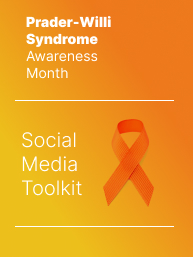Prader-Willi syndrome (PWS) is a rare and complex genetic disorder resulting from an abnormality on the 15th chromosome, characterized by insatiable hunger, growth hormone deficiency and behavior challenges. It occurs in males and females equally and in all races.1 It has a a birth prevalence of 1/10,000 to 1/30,000, and an estimated prevalence of approximately 10,000 to 20,000 living individuals in the United States.

A suspected diagnosis of PWS is usually made by a physician based on clinical symptoms, including hypotonia (muscle weaknesses or “floppiness”), low muscle mass, and weak suck in newborns, but is confirmed by genetic testing.2
Newborns with PWS must often be treated for extended periods in the hospital and may require tube feeding and other supportive care. In developed countries, where genetic testing is more readily available, patients are often diagnosed within the first month of life. Nearly all individuals with PWS are diagnosed by age one.3
Living with Prader-Willi syndrome (PWS)
Prader-Willi syndrome has many different physical, behavioral, and cognitive symptoms. These symptoms will vary from person to person but most commonly affect the brain, particularly the hypothalamus.4
Known symptoms of PWS include:
- Muscle and Growth Delay: From birth, people with PWS typically have weak muscle tone and less muscle mass. Children with PWS can take about twice as long to reach developmental milestones, (sitting, crawling, walking, speaking) as their siblings or other children their age.5
- Growth Hormone Deficiency: As a child with PWS develops, a growth hormone deficiency may result in short stature and small hands and feet, learning challenges problems as well as incomplete sexual development.6
- Insatiable Hunger: A distinctive trait of PWS is an unending appetite, also known as hyperphagia. Starting at age two, most people with PWS begin to gain excess body fat even without an increase in caloric intake7 and are prone to excess body fat accumulation throughout life.
- Behavioral Challenges: People with PWS often face various behavioral challenges, such as compulsive skin picking, stubbornness, and obsessive-compulsive behaviors.8
Hyperphagia
Nearly all people living with PWS will reach a stage characterized by hyperphagia (insatiable hunger).9 For some, this occurs as early as age four, and on average about age eight and then continues into adulthood.10 Hyperphagia occurs because of a failure of the normal appetite regulatory mechanisms in the hypothalamus, which can lead to increased appetite or food consumption, reduced satiety and a range of disruptive food related behaviors, including aggressive food seeking.11
At this stage children and adults are constantly seeking and thinking about food and may:
- Become angry or frustrated if denied food or asked to stop talking about food.
- Often consume any accessible food including frozen food, pet food, and even non-food items.
- Can continue to eat until the stomach ruptures.
- Steal food or money to buy food and hoard and hide food to eat later.
Currently, the only effective intervention is to strictly control access to food. In many cases, family members and caregivers must lock pantry cabinets and refrigerators at home. Individuals with PWS are at risk of suffering significant health and quality of life consequences, including morbid obesity and premature death without such controls in place. While the disease has historically resulted in high mortality rates with an average age of death around 30 years,12 many people are now living beyond 50 years or longer.
Advancements with PWS
While there is no cure for PWS, research continues. More knowledge and understanding of the disease is helping to address the many challenges and symptoms associated with PWS. Since the disease was first discovered in 1956 and confirmed as a genetic disorder in 1981, progress has been made.
- What is Prader-Willi Syndrome, accessed 11 September 2024, https://www.pwsausa.org/what-is-prader-willi-syndrome/ ↩︎
- Diagnosis & Treatment, accessed 12 September 2024, https://www.fpwr.org/prader-willi-syndrome-diagnosis-treatments ↩︎
- Wheeler, A.C., Gantz, M.G., Cope, H.et al.J Neurodevelop Disord15, 37 (2023) ↩︎
- What is Prader-Willi Syndrome, accessed 11 September 2024, https://www.pwsausa.org/what-is-prader-willi-syndrome/ ↩︎
- Butler MG, Meaney FJ, Palmer CG. Clinical and cytogenetic survey of 39 individuals with Prader-Labhart-Willi syndrome. Am J Med Genet. 1986 Mar;23(3):793-809. doi: 10.1002/ajmg.1320230307. PMID: 3953677; PMCID: PMC5494992. ↩︎
- Butler MG, Meaney FJ, Palmer CG. Clinical and cytogenetic survey of 39 individuals with Prader-Labhart-Willi syndrome. Am J Med Genet. 1986 Mar;23(3):793-809. doi: 10.1002/ajmg.1320230307. PMID: 3953677; PMCID: PMC5494992. ↩︎
- Miller JL, Lynn CH, Driscoll DC, Goldstone AP, Gold JA, Kimonis V, Dykens E, Butler MG, Shuster JJ, Driscoll DJ. Nutritional phases in Prader-Willi syndrome. Am J Med Genet A. 2011 May;155A(5):1040-9. doi: 10.1002/ajmg.a.33951. Epub 2011 Apr 4. PMID: 21465655; PMCID: PMC3285445. ↩︎
- What is Prader-Willi Syndrome, accessed 11 September 2024, https://www.pwsausa.org/what-is-prader-willi-syndrome/ ↩︎
- Driscoll DJ, Miller JL, Cassidy SB. Prader-Willi Syndrome. 1998 Oct 6 [Updated 2023 Nov 2]. In: Adam MP, Feldman J, Mirzaa GM, et al., editors. GeneReviews® [Internet]. Seattle (WA): University of Washington, Seattle; 1993-2024. ↩︎
- Miller JL, Lynn CH, Driscoll DC, Goldstone AP, Gold JA, Kimonis V, Dykens E, Butler MG, Shuster JJ, Driscoll DJ. Nutritional phases in Prader-Willi syndrome. Am J Med Genet A. 2011 May;155A(5):1040-9. doi: 10.1002/ajmg.a.33951. Epub 2011 Apr 4. PMID: 21465655; PMCID: PMC3285445. ↩︎
- Hyperphagia in Prader-Willi Syndrome, accessed 11 September 2024, https://www.fpwr.org/hyperphagia-in-prader-willi-syndrome#definition ↩︎
- Butler MG, et al., Genet Med. 2017 Jun;19(6):635-642. ↩︎

Spread Kind Words about PWS.
Use our educational graphics on your social media.